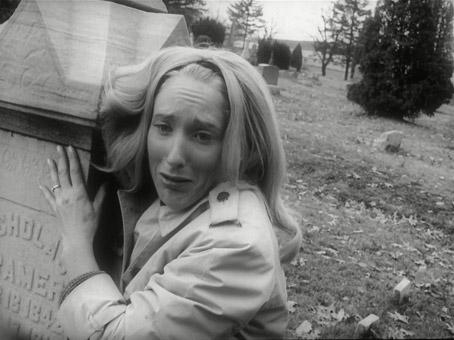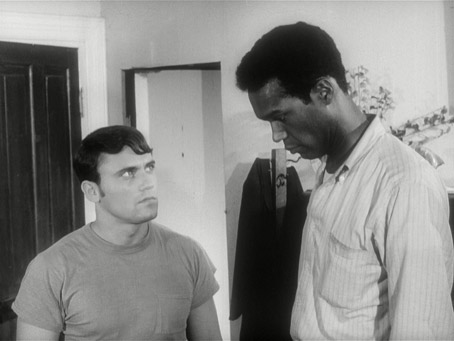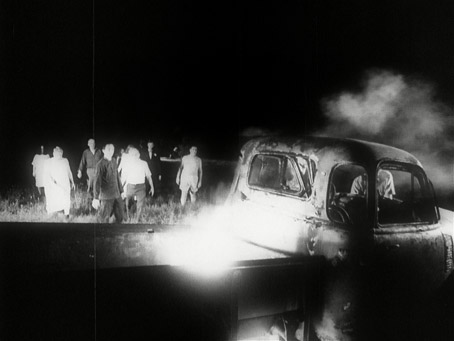|
When it comes to modern horror cinema, it's long since been agreed that Night of the Living Dead, the first feature by one George A. Romero, changed everything. It wasn't alone in this revolution, of course, but was without doubt one of its most important players, one of a handful of visionary films that cut the ties with the genre's literary-influenced and classical past and moved it into the here and now. From this point on a sharp-toothed and heavily accented Romanian aristocrat paying house calls in Victorian England wasn't going to cut it any more. In the new films the horror lived next door, or just down the road, or in that cabin in which you planned to spend your summer break. And it wasn't happening to the well-to-do in the comfortably distanced past, but today and to ordinary people like us. These are the films that reinvented the genre and laid the foundations for the form in which it exists today. In the same year that Rosemary's Baby brought urban horror to mainstream audiences, Night of the Living Dead pretty much wrote the rule book for indie genre film production for years to come.
It all began back in the 60s, when Pittsburgh-based Romero started a production company named Latent Image with his friends Russell Streiner and John Russo and became bored with making the short industrial films and TV commercials that were the company's mainstay (having worked on both myself I can well understand why). He and Russo thus wrote a horror story that could be made on a shoestring but that had commercial potential, pitched it to fellow industrial filmmakers Karl Hardman and Marilyn Eastman and a partnership named Image Ten was formed. Working with a budget of just $114,000, Image Ten members had roles both behind and in front of the camera – Romero himself took charge of the cinematography, he and Russo handled the editing, locals were drafted in as extras, and producers Karl Hardman and Russell Streiner were cast in key supporting roles. And in a time when colour had long since become the norm for genre film production, they shot the whole thing in black-and-white.
I would hope that most of you have at least a passing familiarity with the film, but here's a brief plot summary for the newcomer few. Johnny and his sister Barbara are making their annual pilgrimage to lay flowers on their father's grave when they are attacked by a shuffling man, who knocks Johnny unconscious and chases Barbara to an isolated house. As night falls and the figures outside start to multiply, Barbara is joined by the resourceful Ben, young couple Tom and Judy, and the argumentative Harry Cooper and his wife and child. As TV news reports reveal that radiation from a crashed satellite is causing the dead to rise and devour the living, the occupants of the house fight amongst themselves and struggle to keep the growing army of zombies at bay.

If you've somehow never seen the film and think all this sounds a bit familiar, then know that it was Night of the Living Dead that effectively drew up the blueprint for all zombie movies that followed. Yes, there were zombies in films before this one – the 1943 Jacques Tournier/Val Lewton I Walked With a Zombie is a personal favourite – but they were largely solitary creatures confined to sinister foreign shores. The concept of reanimating the dead en mass and turning them against humankind was explored back in 1959 in Edward L. Cahn's Invisible Invaders, but it was Romero who transformed them into a convincingly lethal cannibalistic force and was the first to realise the genre's potential for social commentary. Indeed, much has been made of the film as an allegory of America's involvement in the Vietnam war, one that casts the zombies as shell-shocked war victims turning on those who sent them to their deaths. Whether this was ever intended remains uncertain, but in a year that saw both the Tet offensive and the My Lai massacre, the parallels were easy to draw, and it certainly seems possible that the prevailing mood in a country so starkly divided over the war did at least exert an influence, especially given the more overt social subtext of the Romero-directed sequel, Dawn of the Dead.
That Barbara is menaced, runs away, and eventually comes under male protection may play like standard operating procedure for its day, but here the initial attack proves so traumatising that she never recovers from it, which proves a cause of concern and frustration for Ben and judgemental irritation for the intolerant Harry. Having a black leading man was a genuine genre (and in some ways movie) milestone, something Romero has repeatedly played down with the assurance that he cast Duane Jones not for his skin colour but because he was simply the best actor he interviewed. But the simple fact is that had this been a studio picture then Jones would never have even been considered for the part in the first place – reluctant to admit it he may be, but Romero's equal opportunities casting policy was a progressive industry rarity back in 1968.
I can only imagine how the film played to audiences on its release – on my first viewing ten years later it certainly scared the hell out of me. We may start on familiar ground with the isolated graveyard setting, a lurching monster and a perfectly timed crack of thunder, but with the fall of night and the arrival of the zombie vigil – the damaged remains of everyday folk who appear from nowhere like a pack of predatory animals sniffing out their next meal – an aura of threatening claustrophobia quickly builds inside the house, and help from outside is just never on the cards. The growing scale of the threat is convincingly suggested though television news broadcasts, which also give rise to the film's one light-hearted moment, as a police chief is asked about the slow movement of the zombies and explains in a wonderfully offhand manner, "Yeah, they're dead, they're all messed up."

It's this speed of movement issue that has so divided genre fandom of late, with the new trend for fast moving zombies decried by traditionalists but an inevitable consequence of both genre development and the perceived need to accelerate the pace of every aspect of the modern rock 'n' roll horror film. There's no doubt that a running zombie is more alarming than a shuffling one, but it's also a more supernatural creation – OK, we're talking fantasy across the board here, but the slow moving zombie does at least have a sort of skewed logic to it, its movement hampered by disorientation, rigor mortis, a body full of embalming fluid and/or whatever killed it in the first place. Running zombies may still act on instinct, but most appear to be a lot fitter than when they were alive – far from slowing them down, death appears to have filled them with energy.
Much of what was innovative back in 1968 still feels surprisingly fresh today. This is partly down to the direction the horror genre has taken in recent years, with its generic teen characters, Buffy-esque wisecracking and post-Evil Dead II stylised combat, three elements you'll see no trace of here. Right from Tom's scruffy brawl with the graveyard zombie, there's an authenticity to almost every aspect of the film, in the clumsiness and urgency of the combat, the sometimes flat interior lighting and imperfect location sound recording, and the no-nonsense conviction of the performances – the characters here react to the situation as we might do ourselves, and their arguments, fears and displays of self-interest feel oddly more real than even those in Diary of the Dead, Romero's recent docudrama take on the genre.
Night of the Living Dead ticks every box on the classic film check sheet. As innovative as it was frightening on its initial release, it has stood the test of time extraordinarily well and transcended its cult status to become one of the most important and influential horror movies of all time. And despite the legion of films that have followed in its wake, this is still unsettling and intermittently disturbing stuff, peaking in the now famous sequence in which the zombies feast on the charred remains of a botched escape attempt, and there can be surely few who will not shudder at the image of a young child rising from the dead to feed off her father's corpse and drive a trowel into the chest of her terrified mother. Slow moving they may be, but the zombies here still represent a most convincing threat, a cannibalistic mob who bring down their prey through an instinct-driven tenacity and sheer weight of numbers. And it's dark out there, and I mean pitch-black with no hint of moonlight, restricting our vision and playing on our basest childhood fears. Here there really are monsters lurking in the darkness, and to wander too far from the protection of home is to risk being attacked and even consumed by unseen creatures of the night.

Night of the Living Dead has been released on video and DVD a number of times over the years in varying conditions and edits, the result of a copyright botch that saw the film fall into the public domain. Probably the most contentious recut was Anchor Bay's 30th Anniversary Edition, which lopped fifteen minutes of Romero's footage and replaced it with newly shot material that Romero had no hand in. The edit on this disc appears to be Romero's original cut.
The film's influence can be measured by the sub-genre it gave birth to and the multitude of zombie-themed films that (eventually) followed in its wake. Romero himself has directed four sequels, the first of which – the 1980 Dawn of the Dead – was to prove every bit as influential to the genre's subsequent development. Italian horror directors fashioned their own low-budget take on Romero's blueprint, which gave rise to some rough-and-ready exploitation cheapies but also a few works of genuine merit, the star player being Lucio Fulci's 1979 Zombi 2. A recent resurgence or interest in zombie movies, driven primarily by younger filmmakers who grew up watching the originals, has reinvigorated the genre, giving rise to works as diverse as the recent comic-horror hit Zombieland and the Spanish camcorder horror [Rec], while Danny Boyle's 28 Days Later successfully adapted the basic premise into a story in which the zombies aren't actually zombies at all.
This was also one of the first modern cult horror movies to get a Hollywood remake, one in which the previously shell-shocked Barbara is transformed into a stony-faced, kick-ass heroine for the post-Aliens audience. Written and executive-produced by Romero (the latter with Russell Streiner) and produced by John Russo, it was directed by Romero's friend and regular effects make-up wizard Tom Savini and favourably reviewed on its release. Personally I'll go with the original every time. Without doubt the most imaginative reworking of the film is not a horror movie at all but an urban western. In his marvellous 1976 Assault on Precinct 13, John Carpenter borrowed as many elements from Night of the Living Dead as he did from Rio Bravo, casting a black actor in the lead, trapping his motley group in an isolated building and surrounding it with an army of silent, unemotional and unrelenting assailants. And it all takes place over the course of a single night. Sound familiar?
Hmmmm. This is a tricky one. My first impression on popping the disc into the player was one of disappointment, as I couldn't see any obvious improvement over previous DVD versions. The film's handheld, deliberately rough-and-ready visual aesthetic does make this a tough call, but a side-by-side comparison of a number of scenes revealed a clear improvement in sharpness, most obvious in detail on clothing, textures, facial close-ups and backgrounds. Unfortunately there's more to it than that. While the daytime and room-lit footage has a pleasing tonal range, the contrast in some of the night scenes is downright aggressive, which delivers solid black levels but really knocks out detail in brighter areas, detail that is clearly visible on Elite's 1998 Special Collector's Edition DVD (see screen grab comparisons below). The THX-approved transfer on Elite's disc was also in better physical shape than the one on Network's Blu-ray – both are largely dirt-free, but the print used for the Network disc has few very pronounced scratches that have not been digitally repaired. Though largely confined to the escape attempt sequence, the tramlines are very visible and at one point there are four on screen at once. The same sequence on the Elite DVD is spotless.
|
|
Network's Blu-ray (left) and Elite's Special Collector's Edition DVD (right). Obviously
both have been reduced in size so the sharpness increase on the Blu-ray
can't really be judged here, but the burned out whites are clearly visible. |
|
The mono soundtrack also shows signs of wear and tear, with a few clearly audible pops and clunks here and there. The dynamic range is as limited on previous versions, but that's to be expected.
Here's where the disc is really let down, with only a trailer (1:38) and no documentary material and no sign of the two commentaries that made the Elite DVD such an essential purchase.
A missed opportunity to produce the definitive home video version of one of the greatest horror movies ever made. The picture is definitely sharper than even the best DVD version, but this edge is lost in the burned-out whites and some very visible print damage, while the almost complete lack of extra features is a real disappointment. Although not as visually crisp, the Elite DVD still rules the roost for now.
|